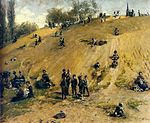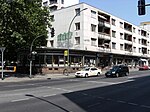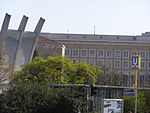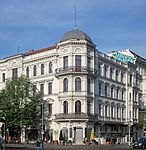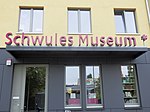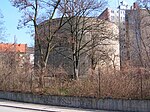Prussian National Monument for the Liberation Wars

The Prussian National Monument for the Liberation Wars (German: Preußisches Nationaldenkmal für die Befreiungskriege) is a war memorial in Berlin, Germany, dedicated in 1821. Built by the Prussian king during the sectionalism before the Unification of Germany it is the principal German monument to the Prussian soldiers and other citizens who died in or else dedicated their health and wealth for the Liberation Wars (Befreiungskriege) fought at the end of the Wars of the Sixth and in that of the Seventh Coalition against France in the course of the Napoleonic Wars. Frederick William III of Prussia initiated its construction and commissioned the Prussian Karl Friedrich Schinkel who made it an important piece of art in cast iron, his last piece of Romantic Neo-Gothic architecture and an expression of the post-Napoleonic poverty and material sobriety in the liberated countries.The monument is located on the Kreuzberg hill in the Victoria Park in the Tempelhofer Vorstadt, a region within Berlin's borough of Friedrichshain-Kreuzberg. The monument was conceived at a time of deteriorating relations between the reactionaries and the reformers of the civic movement within Prussia. The monument is of cast iron, a technique en vogue at the time. Its younger socket brick building is faced with grey Silesian granite and was designed by the Prussian architect Heinrich Strack and realised by the Prussian engineer Johann Wilhelm Schwedler. Its centerpiece is a tapering turret of 60 Prussian feet (18.83 m (61.8 ft)), resembling the spire tops of Gothic churches.
Excerpt from the Wikipedia article Prussian National Monument for the Liberation Wars (License: CC BY-SA 3.0, Authors, Images).Prussian National Monument for the Liberation Wars
Am Weinhang, Berlin Kreuzberg
Geographical coordinates (GPS) Address Nearby Places Show on map
Geographical coordinates (GPS)
| Latitude | Longitude |
|---|---|
| N 52.487661111111 ° | E 13.381463888889 ° |
Address
Nationaldenkmal für die Befreiungskriege
Am Weinhang
10965 Berlin, Kreuzberg
Germany
Open on Google Maps
